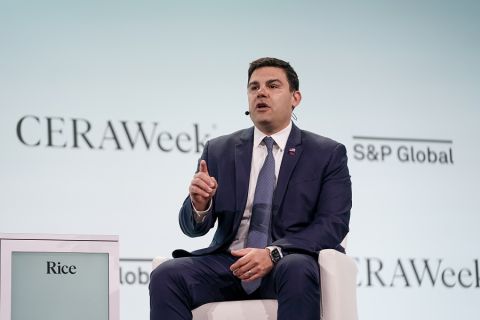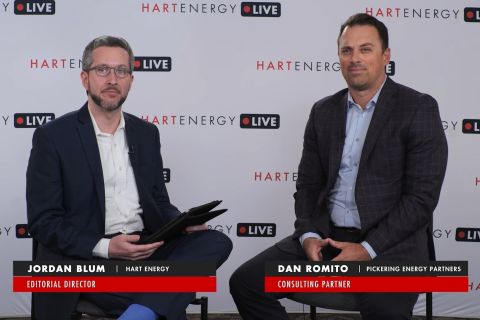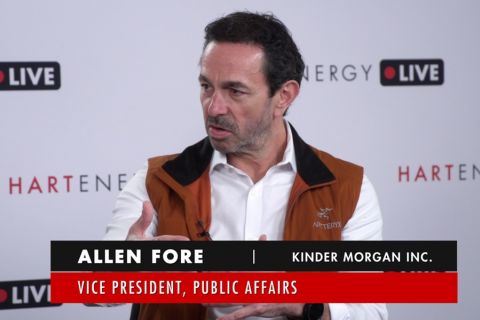
(Source: HartEnergy.com; ricochet64, flight of imagination/Shutterstock.com)
Success of the energy transition will hinge on sufficient investment and supply chain reliability of natural gas, the president and CEO of LNG market pioneer Tellurian Inc. said March 25. Failure on that front will result in emerging economies turning to coal, Octávio Simões told viewers of the S&P Global Platts LNG Virtual Conference.
Aspirations for zero-carbon “green” LNG in 30 years don’t take into account that the transition is not exclusively a U.S. issue and that emerging economies around the world need energy to grow now.
“We cannot tell the rest of the world to put their lives on hold for a couple of generations,” Simões said.
For example, Bangladesh has continued its construction of coal-fired power plants in accordance with its 2016 energy plan, although consultancy Rystad noted that the country has pared about two-thirds of projected capacity since then as part of its push toward carbon neutrality.
But it’s not just emerging economies. Post-pandemic U.S. coal consumption is expected to rise 16% in 2021 compared to 2020 and another 3% in 2022. Consumption in China and India is expected to rise, as well.
The shift to cleaner fuels necessitates trust that those fuels will be made available, and Simões acknowledged that he was encouraged by the approach of President Joe Biden’s administration toward supply chain reliability.
“It’s one thing to do aspirations of 30 years from now that can be achieved,” he said. “What are we doing tomorrow? What are we doing five years down the road?”
ESG Hurdles
The near term presents harsh challenges in terms of attracting capital. This is a growing market that needs financing and capex, Simões said, but the ESG umbrella complicates those efforts. By comparison, the coal industry, a mature industry, can maintain market share or even grow with very little capex.
“[By restricting] capital from fossil fuels, in general, then we are actually hurting the fossil fuel which can actually solve the problem, which is natural gas,” he said. “That’s the kind of debate and discussion that is missing—this practical approach to what is rational and realistic.”
It’s not only oil and gas executives but industry observers who admit to being stunned at the rapid ascension of ESG concerns.
“As a ratings agency, obviously we speak with investors regularly and it’s almost surprising—perhaps it shouldn’t be—the prominence that ESG considerations have started to take in our conversations with investors as it relates to all carbon-based facilities, whether it’s an LNG facility or midstream or refiner,” Stephen Goltz, director and lead analyst for the energy infrastructure group at S&P Global Ratings, said during a media briefing prior to the LNG conference. “The investing community is increasingly becoming energized around ESG considerations.”
But are those ESG considerations, in fact, hindering actual ESG efforts? Occidental Petroleum Corp. does not operate in the LNG sphere but its CEO, Vicki Hollub, said it still contends with investment challenges due to ESG concerns despite aggressive steps to reduce its carbon footprint.
“What’s missing here—and I’m a little bit disappointed right now—is the lack of engagement and interest from the bigger banks,” Hollub said during a March 22 webinar hosted by Columbia University’s Center on Global Energy Policy. “If we could get the bigger banks investing in things, that will make this much difference in the world. Rather than putting your attention and dollars where they are to try to mitigate, but on a much smaller scale, we could really advance this a lot faster.”
There are some indications that some officials at large lenders are looking for ways to invest in fossil fuel companies engaged in the energy transition.
“We have been having conversations with some of the largest of the national banks who are definitely rolling up their sleeves and trying to make structures that work for them,” said Ellen Friedman, partner at the Nixon Peabody law firm and co-leader of its energy and infrastructure projects team. However, it takes some effort to move proposals past credit committees and to in which they can be proposed to an investment committee.
Contract Complications
But other hurdles exist for the second wave of projects.
“There have been a number of projects on the U.S. Gulf Coast that have been canceled,” Goltz said. “In many cases, that’s largely due to the fact that these projects have been unable to secure long-term contracts.”
In some ways, the reluctance to engage in long-term LNG contracts is counterintuitive. Locking into prices on a long-term basis removes the specter of price volatility. Customers still want that price certainty, Goltz said, but it’s uncertainty tied to the energy transition that convinces them to step back. They don’t know what the gas market will look like in 20 years.
Another reason for customers to be contract-shy at the moment is the sheer level of competition in the U.S. LNG market at this stage of development.
“We saw a tremendous amount of North American LNG capacity financed over the last 10 years,” Ross Wyeno, lead analyst for LNG analytics, Americas, for S&P Global Platts, said during the media briefing. The first wave of development has passed, he said. The second wave, on the way, is represented by projects like Venture Global LNG’s Calcasieu Pass; Exxon Mobil Corp. and Qatar Petroleum’s Golden Pass; a JV including Royal Dutch Shell, Petronas, Mitsubishi, PetroChina and KoGas developing LNG Canada; and Sempra LNG’s Energía Costa Azul.
“What you’re seeing is that most of the buyer demand at this point has largely been satisfied,” Wyeno said. “It’s a bit of a culling of the herd, potentially, but it doesn’t mean all the projects are out of the game. It just means that only the best will make it through.”
‘Transformational’
Tellurian’s strategy with its Driftwood LNG project was devised by co-founder and Executive Chairman Charif Souki, who also founded Cheniere Energy Inc. Souki has long discussed a global LNG marketplace in which the price is untethered to U.S. benchmark Henry Hub.
Simões described Driftwood’s approach as creating LNG deals linked entirely to the regional price, such as the Japan Korea Mark (JKM) in Asia and the Transfer Title Facility (TTF) in Europe.
“We are going to be able to create a project that deals to you LNG on a basis linked 100% to what you face in your own domestic market,” he said. “This is transformational.”
Wyeno is a fan.
“They’re as good of an LNG development group as is out there,” he said. “They are incredibly aggressive and flexible in terms of how they want to sell capacity out of this facility. They propose a number of different contracting structures including, more recently, these equity positions and vertical integration back up to the wellhead production site.”
And yet, innovation is met with reluctance.
“I think that, if anything, it’s telling that a group that is that talented, that well regarded, with that much flexibility in terms of how they could potentially sign up these cargoes,” Wyeno said, “is themselves struggling to find buyers right now.”
Recommended Reading
From Satellites to Regulators, Everyone is Snooping on Oil, Gas
2024-04-10 - From methane taxes to an environmental group’s satellite trained on oil and gas emissions, producers face intense scrutiny, even if the watchers aren’t necessarily interested in solving the problem.
EQT’s Toby Rice: US NatGas is a Global ‘Decarbonizing Force’
2024-03-21 - The shale revolution has unlocked an amazing resource but it is far from reaching full potential as a lot more opportunities exist, EQT Corp. President and CEO Toby Rice said in a plenary session during CERAWeek by S&P Global.
Exclusive: Dan Romito Urges Methane Mitigation Game Plan
2024-04-08 - Dan Romito, the consulting partner at Pickering Energy Partners, says evading mitigation responsibility is "naive" as methane detection technology and regulation are focusing on oil and gas companies, in this Hart Energy Exclusive interview.
Kinder Morgan Exec: Building Pipelines ‘Challenging, but Manageable’
2024-04-05 - Allen Fore, vice president of public affairs for Kinder Morgan, said building anything, from a new road to an ice cream shop, can be tough but dealing with stakeholders up front can move projects along.
CEO: Linde Not Affected by Latest US Green Subsidies Package Updates
2024-02-07 - Linde CEO Sanjiv Lamba on Feb. 6 said recent updates to U.S. Inflation Reduction Act subsidies for clean energy projects will not affect the company's current projects in the United States.





